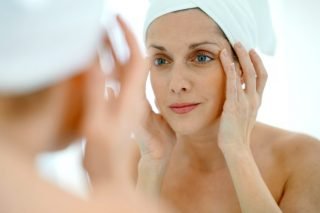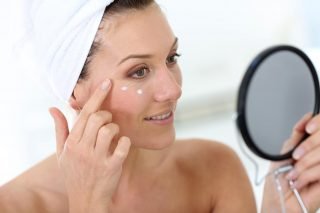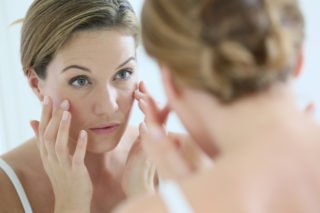For some, the idea of using acid on your face may sound scary – however, it’s actually one of beauty’s best skincare practices. The use of facial acids as part of your skincare regime can lead to a clearer and brighter complexion. Not only do they help in exfoliating the skin, but they can also provide anti-aging and hydrating benefits. Still, it’s important not to overuse acids as they can lead to dry and irritated skin.
With acid being an integral part of many beauty products, one can often feel overwhelmed with the choice of how and what to choose. That being said, read on for a full guide to face acids.
Facial acids are categorized as alpha hydroxyl acids (AHA) beta hydroxyl acids (BHA) and, as of late, polyhydroxy acids (PHA).
1. Alpha Hydroxy Acids (AHA)
AHAs work on the surface of the skin, dissolving the bond that keeps dead skin cells attached to the skin. This breakdown makes way for newer cells which provide a softer and smoother surface. AHAs can be used for all skin types.

goodluz/shutterstock
AHAs don’t infiltrate deep below the surface of the skin, yet they are able to reduce the appearance of fine lines and wrinkles. Essentially, AHAs are anti-aging acids.
The most popular AHA is definitely glycolic acid.
2. Beta hydroxy acid (BHA)
Unlike AHAs, BHAs penetrate deep into the skin, helping to remove dead skin cells and unclog pores which makes it the best acid for those battling acne-ridden skin, oily skin and blackheads.
The most popular (and only) BHA is salicylic acid.
3. Polyhydroxy acid (PHA)
PHAs are the lesser-known category of facial acids, but they work just as well as AHAs and BHAs.
Similar to AHAs, PHAs break down the bond that keeps dead cells on the surface of the skin. However, as PHA molecules are much larger, they do not penetrate the skin as deeply as AHAs. Instead, they work solely on the skin’s surface. This action makes them perfect for individuals with sensitive skin or those that find other acids too strong.

goodluz/shutterstock
Some PHAs include gluconolactone acid and lactobionic acid.
Popular facial acids
Glycolic acid
Extracted from sugar cane, glycolic acid is the most popular (and smallest) AHA, being a staple in many skincare products.
As it’s used as an exfoliant(due to its ability to softly penetrate into the skin), glycolic acid helps remove dead skin cells from the skin’s surface, producing fresh new skin cells as well as stimulating collagen and elastin. If you’re looking for anti-aging acid, glycolic acid is a top choice as the invigoration of both collagen and elastin can help with fine lines and wrinkles as well as provide a clearer and brighter complexion.
Lactic acid
Obtained from fermented milk, lactic acid works just like glycolic acid but is much gentler and less-irritating, making it ideal for dry and sensitive skin. The acid not only exfoliates, but it also moisturizes the skin at the same time – smoothing away fine lines and wrinkles. This then provides a brighter, youthful complexion without any irritation.
Salicylic acid
Known as the only BHA, salicylic acid is mostly used either in the fight against acne or by those battling very oily and or congested skin. However, it can also be found as an ingredient in spot treatments for those with normal to combination skin. It’s also often used in chemical peels at clinics.
Not only does salicylic acid exfoliate the top layer of the skin, but being much smaller in molecule size than glycolic acid and lactic acid- salicylic acid also penetrates deep into the skin cleansing and unclogging pores.

goodluz/shutterstock
Hyaluronic acid (HA)
Unlike the other acids on this list, hyaluronic acid (often listed as sodium hyaluronate) isn’t acid at all. Hyaluronic acid is a natural humectant – attracting and retaining moisture from the air and delivering it to the skin, thus providing it with deep hydration. This hydration boost results in a firmer plumped-up appearance, making it perfect for those dealing with dry and dehydrated skin. The plumped-up appearance also helps diminish the look of fine lines and wrinkles.
We are born with high levels of hyaluronic acid in our bodies, yet the amount decreases as we age.
Retinol (retinoic acid)
Retinol is a form of vitamin A and when applied to the skin, it is converted to retinoic acid. Although rich in anti-aging properties, retinol addresses other skin concerns such as sun damage, pores, and acne. It is suitable for most skin types but may be too harsh for those with underlying skin conditions like eczema or rosacea.
Mandelic acid
Mandelic acid is an AHA obtained from almonds. Similar to lactic acid, its’ molecular structure prevents it from penetrating the skin deeply, leaving it to exfoliate on the surface of the skin- ensuring less irritation. It helps even out pigmentation which is why it’s commonly used in peels for ethnic skin. It’s perfect for those with oily and sensitive skin.
Azelaic acid
Derived from yeast, azelaic acid is commonly found in prescribed creams. It helps to unclog pores, even skin tone, as well as reduce inflammation – which makes it perfect for those dealing with rosacea or eczema.
Kojic acid

Photo by Gustavo Fring from Pexels
Kojic acid has become a principal ingredient in Asian skincare products due to its whitening properties. Created by bacteria used in the fermentation of rice wine, kojic acid helps to even out skin tone by constraining the enzyme that helps produce melanin. That being said, it’s often used to treat dark spots and hyperpigmentation. However, it can cause irritation if you have sensitive skin.
Ascorbic acid
Unlike citric acid that’s derived from oranges and lemons, ascorbic acid is pure vitamin C. However, they work the exact same way. Due to its rich vitamin C content, ascorbic acid contains powerful antioxidant properties that help protect the skin from the free radicals that would cause premature aging. It’s also used to treat dark spots and hyperpigmentation.
Ferulic acid
This acid is extremely rich in antioxidants as it’s derived from plants, vegetables, nuts, and seeds. It stabilizes vitamin C and E in our skin, making it one of the best skincare acids when it comes to anti-aging.
Malic
Naturally obtained from apples, malic acid is another AHA that helps prevent and improve hyperpigmentation. It also provides anti-aging benefits by encouraging the production of collagen.
Using facial acids
Once you decide to incorporate facial acids into your skincare regime, there are a few things you need to be mindful of.
Firstly, it’s important to never, ever mix face acids as the products could either work against each other or make the other product less effective. Thus, never mix BHAs with AHAs. To avoid this, you can use one type of acid in the morning and the other acid in the evening.
Lastly, as great as acids are, they can potentially make the skin more sensitive to UV rays. Therefore, it’s important to end your skincare routine with an SPF 30 or higher. Click here to find out how else you can preserve your skin, according to Harvard Medical.



![women [longevity live]](https://longevitylive.com/wp-content/uploads/2020/01/photo-of-women-walking-down-the-street-1116984-100x100.jpg)











One Comment